What Makes a School Hall of Fame Wall Truly Great?
The best school hall of fame walls do more than simply display names and dates—they tell compelling stories, inspire current students, and create lasting connections between past and present. Whether you’re planning a traditional plaque display or an advanced interactive installation, understanding what separates exceptional recognition walls from mediocre ones is essential to creating a display that serves your school community for years to come.
Modern school hall of fame walls have evolved significantly beyond simple wooden plaques. Today’s most effective installations combine thoughtful design, strategic placement, engaging content, and—increasingly—digital technology to create recognition experiences that resonate with multiple generations of students, alumni, and visitors.
Key Elements of Outstanding Hall of Fame Walls:
- Clear Purpose & Selection Criteria: Well-defined standards for induction that align with school values
- Compelling Visual Design: Professional aesthetics that complement the architectural environment
- Engaging Content: Rich narratives that go beyond basic biographical information
- Strategic Location: High-visibility placement that maximizes impact and accessibility
- Sustainability: Design that accommodates future growth and updates
- Accessibility: Inclusive design that allows all visitors to engage with content
- Technology Integration: Modern solutions that enhance rather than overshadow recognition
Types of School Hall of Fame Walls
Traditional Physical Displays
Traditional hall of fame walls remain popular for their permanence and formal presence. The best examples combine classic aesthetics with thoughtful design.
Engraved Plaque Walls
Engraved plaque installations continue to be among the most common recognition formats in schools. The best plaque walls feature:
- Consistent Design Language: Uniform plaque sizes, finishes, and typography create visual cohesion
- Quality Materials: Bronze, brass, or high-grade aluminum plaques mounted on wood, stone, or architectural panels
- Proper Spacing: Adequate room between plaques prevents crowding and allows for future expansion
- Professional Lighting: Dedicated illumination ensures readability and creates visual impact
- Organizational Logic: Chronological or categorical arrangement helps visitors navigate content
High-quality plaque walls typically cost between $150-$400 per plaque depending on size and materials, with mounting systems and lighting adding to overall project costs. Schools should budget for 20-30% more plaques than initial inductees to accommodate 5-10 years of growth.
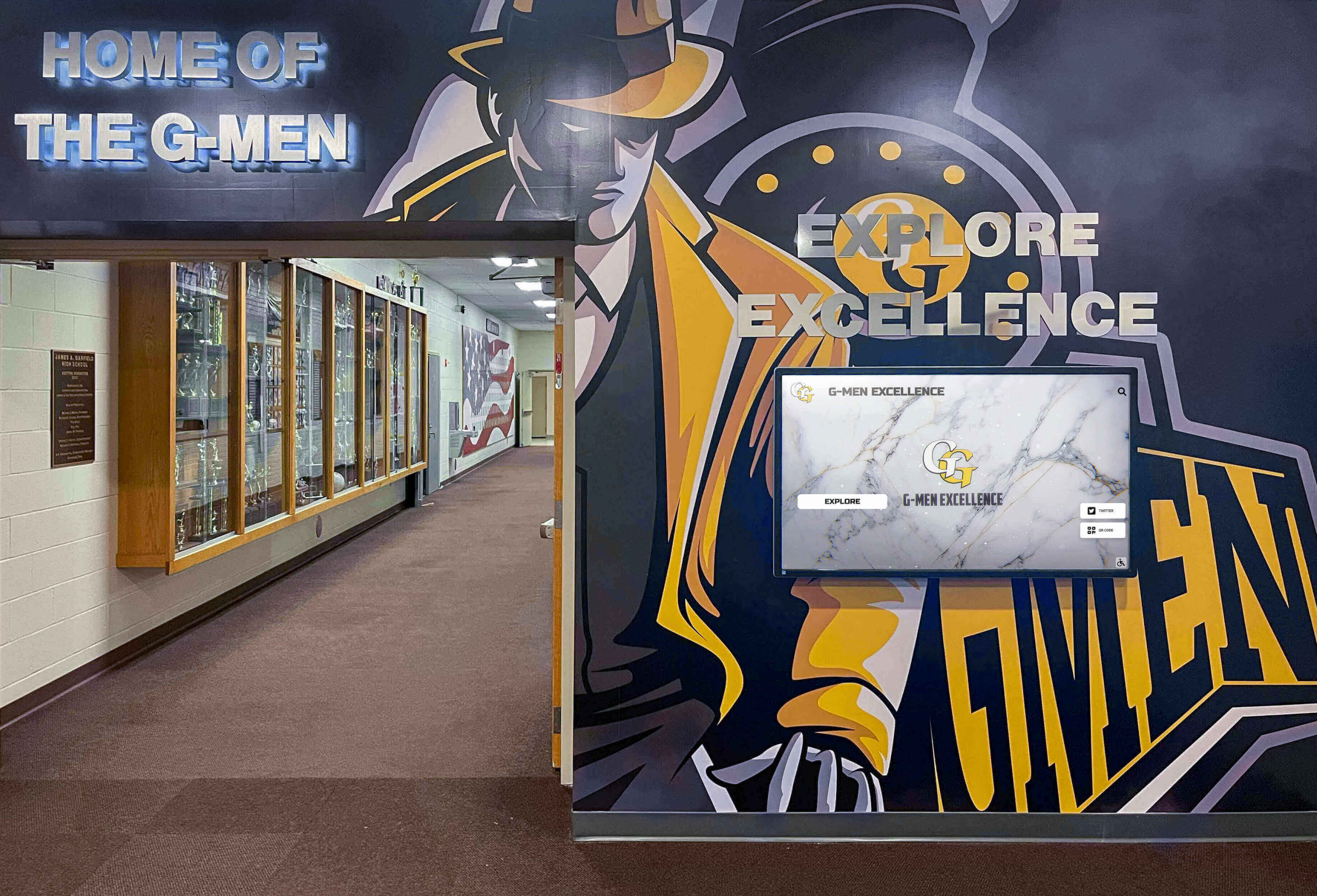
Photo Display Walls
Photo-based recognition walls create powerful visual connections between viewers and inductees. The most effective photo displays incorporate:
- Professional Photography: High-resolution portraits shot in consistent styles with appropriate backgrounds
- Accompanying Information: Plaques or labels providing names, years, achievements, and brief biographical details
- Protective Framing: UV-resistant glazing and archival matting preserve photos for decades
- Modular Mounting Systems: Grid-based arrangements allow for future additions without disrupting existing displays
- Context Elements: Timeline markers, achievement categories, or thematic groupings help tell larger stories
Photo walls work particularly well for distinguishing alumni, championship teams, or faculty recognition. Consider digital printing on metal substrates as a durable, modern alternative to traditional photographic prints.
Trophy and Memorabilia Cases
Three-dimensional displays create museum-quality experiences that bring achievements to life through physical artifacts:
- Championship Trophies: Team awards, individual honors, and competition hardware
- Uniforms and Equipment: Game-worn jerseys, equipment from record-setting performances
- Historical Documents: Newspaper clippings, programs, certificates, and correspondence
- Contextual Graphics: Printed backgrounds providing statistics, timelines, and achievement details
- Security Features: Locked cases with alarm systems for valuable items
The best trophy case displays rotate exhibits seasonally or annually, maintaining visitor interest and accommodating limited display space. Combine physical artifacts with digital displays that provide extended information about featured items and the people associated with them.
Modern Digital Hall of Fame Walls
Digital recognition solutions offer flexibility and interactivity that traditional displays cannot match. The most successful digital installations include:
Interactive Touchscreen Displays
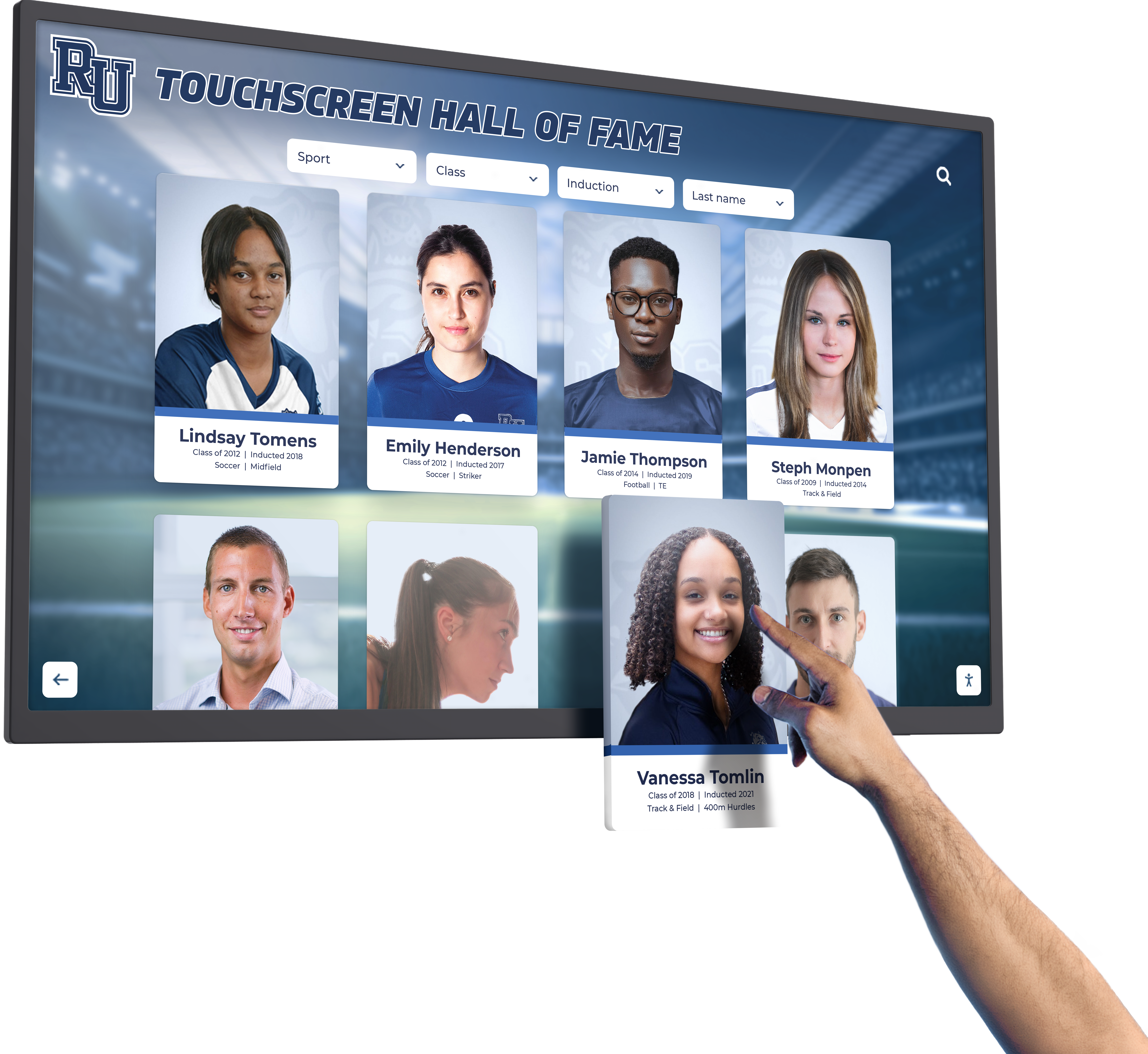
Interactive touchscreens have become the gold standard for school recognition programs. The best touchscreen hall of fame walls feature:
- Intuitive Navigation: Simple, clean interfaces that visitors of all ages can use without instruction
- Rich Multimedia Content: Photos, videos, audio clips, documents, and interactive timelines
- Search Functionality: Name-based searching, category filtering, and achievement browsing
- Unlimited Capacity: Digital storage accommodates hundreds or thousands of inductees without physical space constraints
- Easy Updates: Content management systems allow staff to add inductees, correct information, and refresh displays remotely
- Analytics Capabilities: Usage tracking helps schools understand engagement patterns
Solutions like Rocket Alumni Solutions provide dedicated touchscreen software designed specifically for educational recognition, with content management tools that make updates simple even for non-technical staff. These systems typically include both the physical touchscreen hardware and cloud-based software for content management.
Commercial-grade touchscreens suitable for school environments range from 43-inch displays ($3,000-$5,000 installed) to 75-inch or larger installations ($8,000-$15,000+). Factor in content development, software licensing, and ongoing maintenance when budgeting.
Video Wall Installations
Large-format video walls create dramatic visual impact in lobbies, gymnasiums, and auditoriums:
- High-Resolution Displays: 4K or higher resolution ensures crisp text and images viewable from distance
- Content Rotation: Automated playback cycles through inductee profiles, achievement highlights, and school history
- Event Integration: Live displays during ceremonies, games, and school functions
- Multiple Content Zones: Split-screen layouts allow simultaneous display of different information
- Professional Presentation: High-brightness commercial panels maintain visibility in well-lit spaces
Video walls work best for passive viewing in high-traffic areas where visitors may not stop for extended periods. Combine with QR codes that direct viewers to detailed online profiles for those wanting more information.
Hybrid Recognition Systems
The most sophisticated school hall of fame walls combine physical and digital elements for maximum impact:
Physical Components:
- Monument-style base or surround providing permanent presence
- Architectural integration with school branding and design themes
- Physical plaques for recent inductees maintaining traditional aesthetics
- Trophy cases for three-dimensional artifacts
Digital Components:
- Central touchscreen for interactive exploration
- Video displays for dynamic content presentation
- QR codes linking to extended online content
- Mobile app integration for remote access
Hybrid approaches appeal to different audience preferences and age groups. Alumni who remember traditional displays appreciate physical elements, while current students engage naturally with digital interfaces. This combination ensures your hall of fame wall remains relevant across generations.

Design Best Practices for School Hall of Fame Walls
Location and Space Planning
The best school hall of fame walls are positioned where they receive maximum visibility while providing appropriate space for viewing:
Ideal Locations Include:
- Main Entrances and Lobbies: First impression spaces where visitors naturally gather
- Athletic Facilities: Gymnasiums, field houses, and training areas for sports recognition
- Academic Buildings: Science wings, arts centers, or libraries for specialized recognition
- Corridors and Hallways: High-traffic transitional spaces where students pass daily
- Alumni Centers: Dedicated spaces for gatherings and fundraising events
Avoid isolated locations regardless of available wall space. A perfectly designed hall of fame wall delivers minimal impact if visitors never encounter it. Consider traffic patterns, sight lines, and natural gathering points when selecting locations.
Allow at least 8-10 feet of clear floor space in front of displays to prevent congestion. For touchscreen installations, ensure the screen center height is 48-52 inches for accessibility compliance and comfortable use by visitors of varying heights.
Visual Design Elements
Professional visual design transforms recognition walls from simple information displays into compelling experiences:
Color and Material Selection
The best hall of fame walls complement rather than compete with their architectural surroundings:
- Coordinate with School Colors: Incorporate institutional colors through backgrounds, accent elements, or lighting
- Consider Existing Finishes: Match or complement nearby materials like wood, stone, metal, or painted surfaces
- Ensure Sufficient Contrast: Text and images must remain readable from typical viewing distances (6-12 feet)
- Select Durable Materials: Choose finishes appropriate for the environment and maintenance capabilities
- Create Visual Hierarchy: Use color to distinguish sections, time periods, or achievement categories
Commercial designers recommend investing 15-20% of total project budgets in professional design services. Experienced designers understand how to balance aesthetic appeal with practical considerations like maintenance, durability, and future expansion.
Typography and Readability
Text legibility is crucial for effective recognition displays:
- Font Selection: Choose professional typefaces that align with school branding and ensure readability at distance
- Size Requirements: Headline text should be readable from 10-12 feet; body text from 3-6 feet
- Contrast Ratios: Maintain minimum 4.5:1 contrast between text and backgrounds for accessibility compliance
- Information Hierarchy: Use size, weight, and positioning to guide viewers through content logically
- Consistency: Apply the same typographic standards across all elements for professional appearance
Test physical mock-ups or full-scale printouts at actual viewing distances before finalizing designs. What looks appropriate on a computer screen may prove too small or too large when viewed in the actual installation environment.
Content Strategy and Development
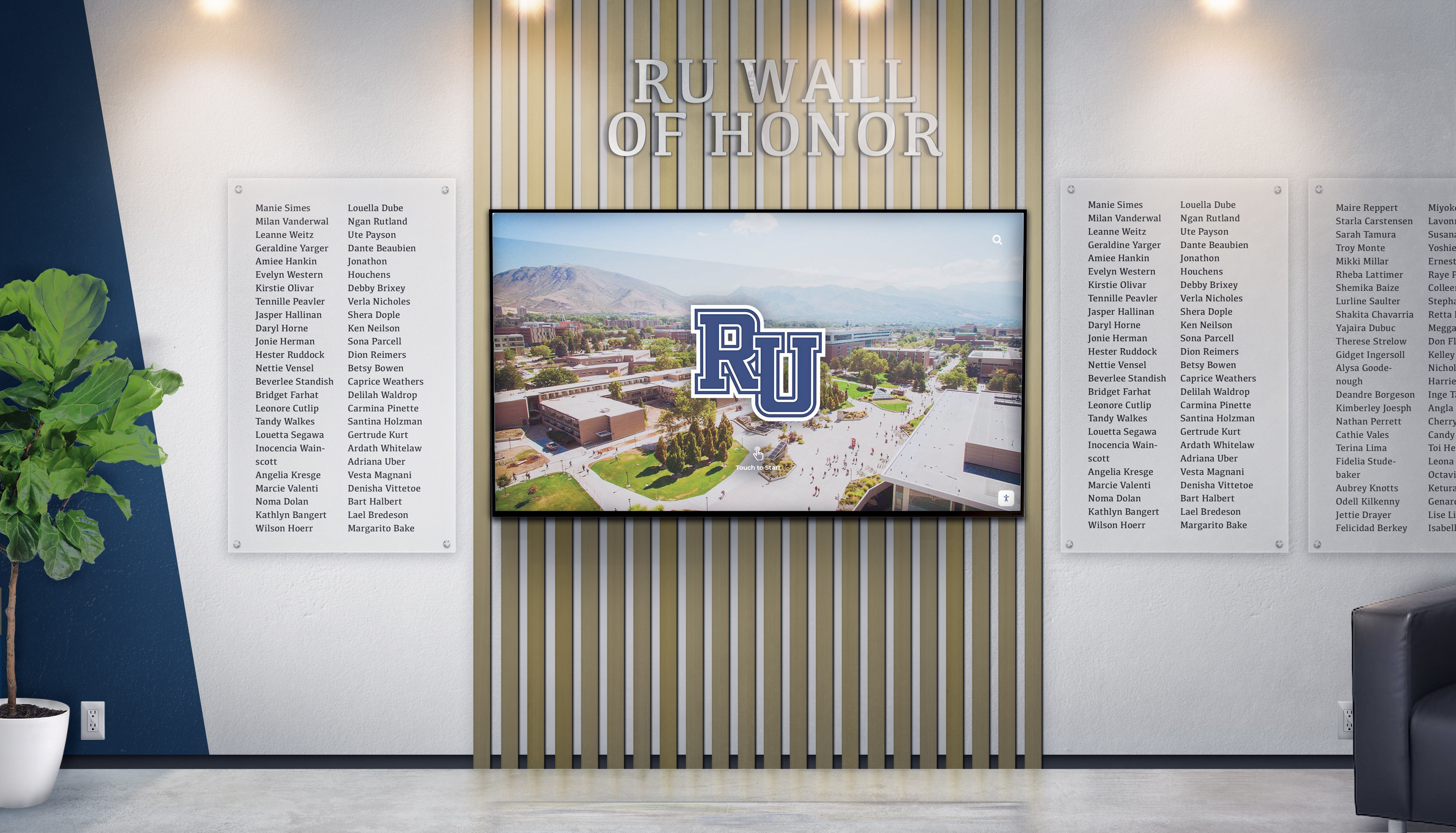
The content displayed on your hall of fame wall is equally as important as the physical design. The best installations feature:
Compelling Biographical Content
Move beyond basic facts to share narratives that connect with viewers emotionally:
- Achievement Context: Explain the significance of accomplishments beyond statistics
- Personal Stories: Include anecdotes that reveal character, dedication, and impact
- Quotes and Testimonials: First-person perspectives from inductees or those who knew them
- Impact and Legacy: Describe how achievements influenced the school or broader community
- Career Trajectories: For alumni, show how school experiences shaped future success
Biographical content typically ranges from 150-250 words for traditional displays to 500-1000 words for digital installations where space constraints don’t apply. Commission professional writers or work with communications staff to ensure consistent quality and voice.
Effective Use of Multimedia
Digital hall of fame walls allow incorporation of rich media that traditional displays cannot support:
- Video Interviews: Recorded conversations with inductees sharing memories and advice
- Historical Footage: Game highlights, performances, or event recordings
- Photo Galleries: Multiple images showing career progression and key moments
- Audio Clips: Recorded speeches, performances, or oral histories
- Document Scans: Letters, certificates, newspaper articles, and other historical materials
For schools implementing digital recognition displays, video content proves particularly powerful. Three-minute interview segments with inductees create emotional connections and provide current students with role models sharing authentic experiences.
Implementation Process for School Hall of Fame Walls
Planning Phase
Successful hall of fame wall projects begin with thorough planning that addresses both immediate needs and long-term goals:
Establish Clear Objectives
Define what you want your hall of fame wall to accomplish:
- Recognition Goals: Who will be honored and what criteria determine inclusion?
- Audience Considerations: Which groups will interact with the display (students, alumni, visitors, donors)?
- Educational Purpose: What lessons or values should the display communicate?
- Community Building: How will recognition strengthen connections within your school community?
- Fundraising Alignment: Can the project support development efforts through naming opportunities or donor recognition?
Document objectives clearly to guide all subsequent decisions about design, technology, content, and placement.
Form a Selection Committee
The most respected hall of fame programs establish transparent selection processes:
- Diverse Representation: Include administrators, faculty, alumni, students, and community members
- Clear Criteria: Define specific achievements or contributions warranting recognition
- Nomination Process: Create simple procedures for submitting candidates
- Regular Schedule: Hold induction cycles annually or biennially
- Documentation: Maintain records of deliberations and decisions for consistency
Published criteria and transparent processes prevent controversies and ensure the hall of fame maintains credibility over time.
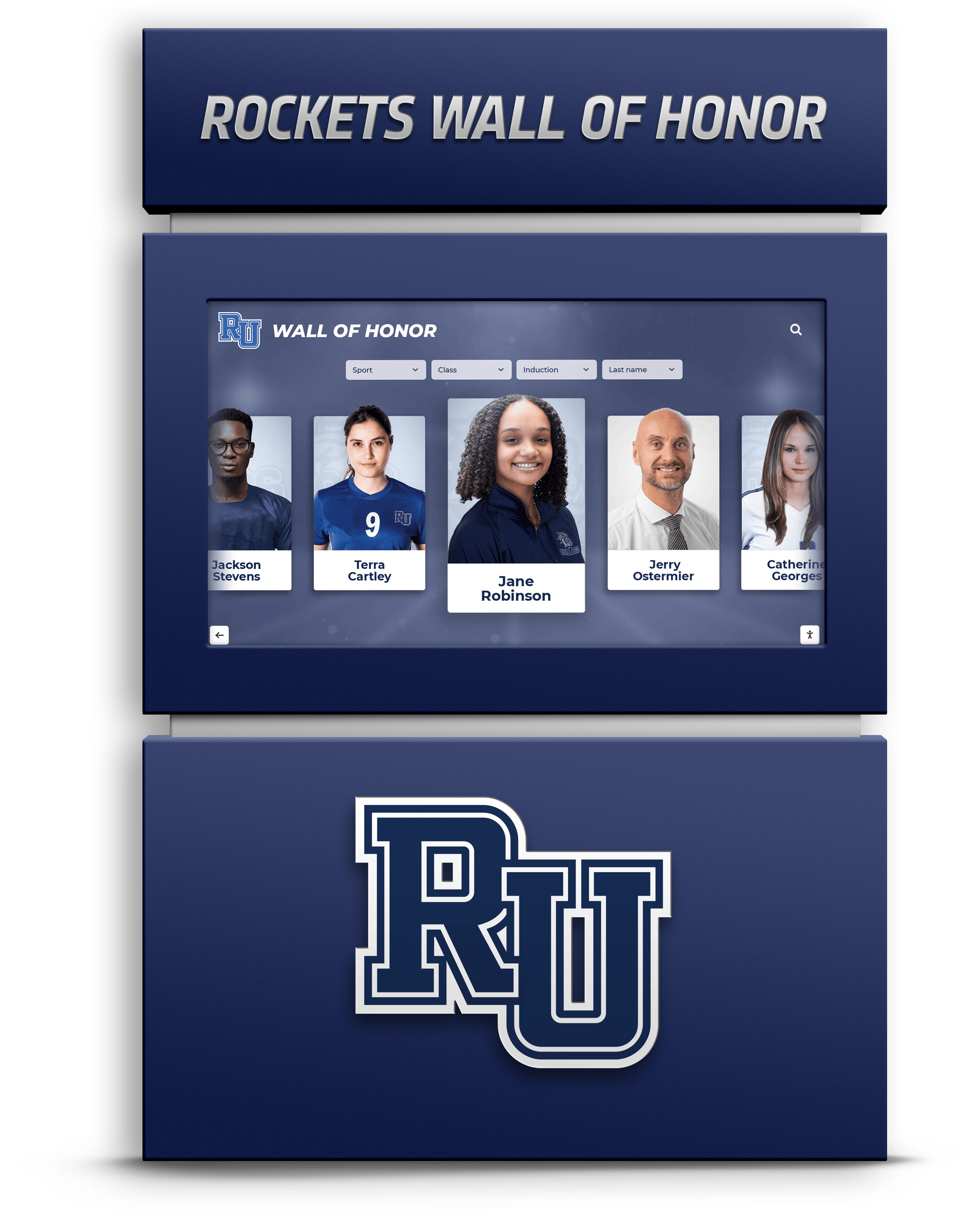
Budget Development
Comprehensive budgets account for all project phases:
Initial Installation Costs:
- Design and planning services (10-15% of total budget)
- Materials and fabrication (40-50%)
- Installation labor and equipment (15-20%)
- Content development including writing, photography, and video production (15-20%)
- Project management and contingency (10%)
Ongoing Costs:
- Annual maintenance and cleaning
- Technology updates and software licensing for digital displays
- Content additions for new inductees
- Lighting replacement and electrical costs
- Insurance and security as needed
Traditional plaque walls typically cost $5,000-$25,000 depending on size and materials. Mid-range digital installations range from $15,000-$50,000. Premium hybrid systems with large touchscreens, custom design, and extensive content development can exceed $100,000.
Many schools successfully phase implementation, starting with foundational elements and adding capabilities over time as budgets allow. Solutions like touchscreen recognition displays can start with basic functionality and expand as schools identify additional content and features they wish to include.
Design and Fabrication
Working with experienced professionals ensures quality results:
Designer and Vendor Selection
Choose partners with relevant experience in school recognition projects:
- Portfolio Review: Examine previous installations in similar environments
- Reference Checks: Contact other schools about their experiences with vendors
- Technical Capabilities: Verify expertise with materials, technologies, and installation requirements
- Support Services: Understand what post-installation support and maintenance vendors provide
- Local Presence: Consider proximity for site visits, installation supervision, and service calls
Request detailed proposals from 3-5 qualified vendors including timelines, detailed budgets, and mockups showing how designs will look in your specific space.
Content Collection and Development
Begin gathering information for inductees early in the process:
- Biographical Research: Compile facts, dates, achievements, and biographical details
- Image Acquisition: Collect high-resolution photos from archives, yearbooks, personal collections, and professional shoots
- Multimedia Production: Schedule interviews, scan documents, and digitize historical materials
- Writing and Editing: Draft and refine biographical content maintaining consistent voice and quality
- Fact Checking: Verify all information for accuracy before finalizing content
Content development often takes longer than anticipated. Begin this process 6-12 months before planned installation to avoid delays.
Installation and Launch
The final phase brings your vision to life:
Site Preparation
Ensure the installation location is ready:
- Structural Verification: Confirm walls can support mounting hardware and display weight
- Electrical Work: Install outlets, lighting circuits, and data connections as needed
- Surface Preparation: Patch, paint, and finish walls before mounting displays
- Protection Measures: Shield surrounding areas from dust, debris, and damage during installation
Professional Installation
Experienced installers ensure displays are mounted securely and look professional:
- Precision Mounting: Level, aligned installation according to design specifications
- Lighting Setup: Proper aiming and adjustment of illumination for optimal visibility
- Technology Integration: Touchscreen calibration, network connections, and software configuration
- Quality Inspection: Thorough review of all elements before final acceptance
Launch Event
Celebrate the completion of your hall of fame wall with a dedicated ceremony:
- Induction Ceremony: Honor initial inductees with formal recognition event
- Community Celebration: Invite alumni, donors, and community members to view the new display
- Media Coverage: Generate publicity through local news, school communications, and social media
- Documentation: Photograph and video record the event for historical archives
A well-executed launch generates excitement that carries forward, encouraging future engagement with the hall of fame wall.
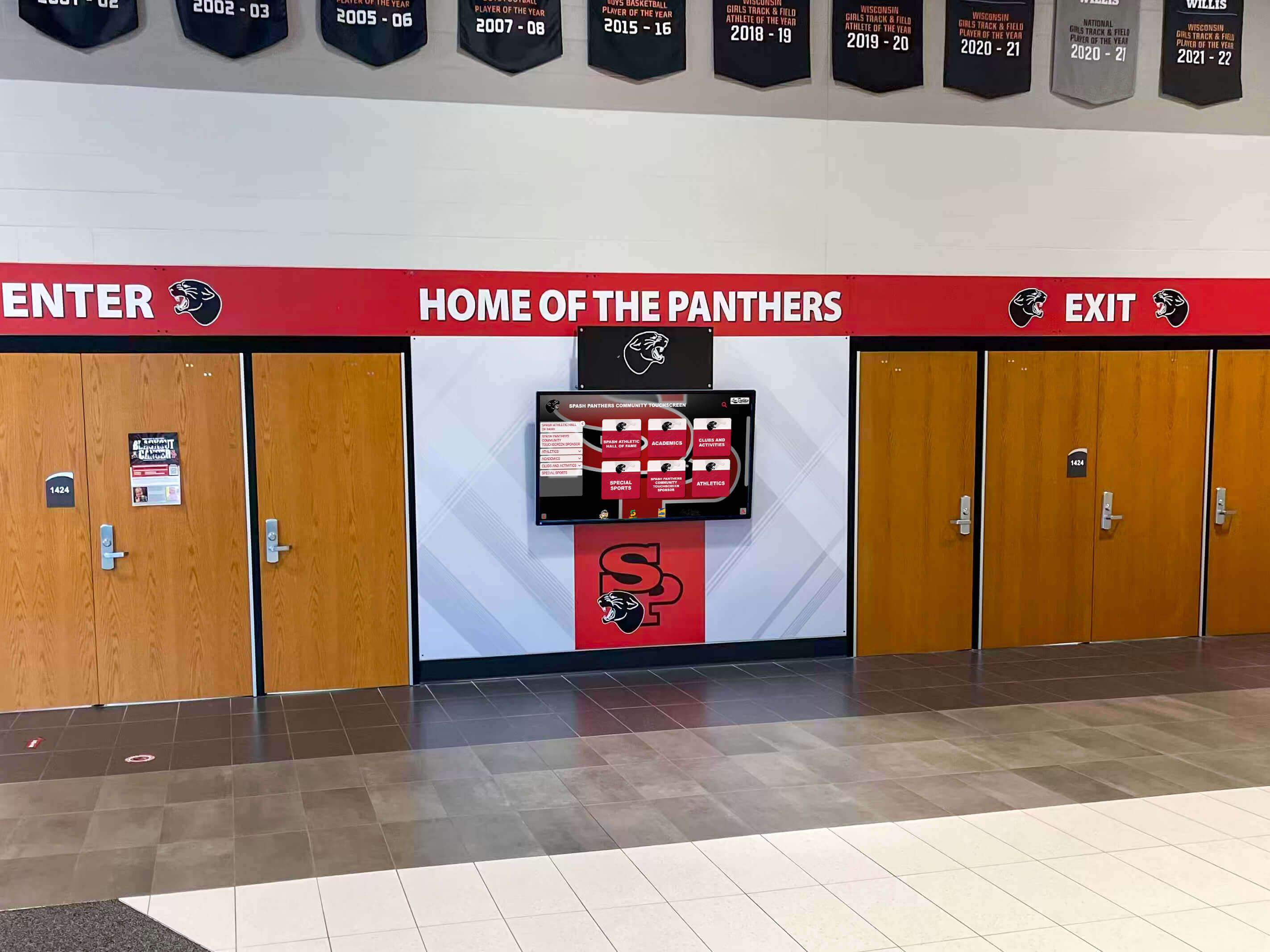
Technology Considerations for Digital Hall of Fame Walls
Schools choosing digital solutions benefit from understanding key technical factors:
Hardware Selection
Commercial-grade displays designed for continuous operation in public spaces outlast consumer electronics:
- Screen Type and Size: LED-backlit LCD panels from 43 to 86 inches depending on viewing distance and available space
- Touch Technology: Projected capacitive touchscreens provide responsive, accurate input
- Brightness Ratings: 400-700 nits for typical indoor environments; higher for areas with significant natural light
- Durability Features: Hardened glass surfaces, robust enclosures, thermal management for reliable operation
- Mounting Options: Wall mounts, floor stands, or custom enclosures matching architectural requirements
Leading commercial display manufacturers include NEC, Samsung, LG, and Sharp. Expect 50,000+ hours of operation (15+ years at 8 hours daily) from quality commercial panels.
Software and Content Management
The software powering your digital hall of fame wall determines ease of use and long-term flexibility:
- User Interface Design: Intuitive navigation requiring minimal instruction
- Content Management System: Web-based administration allowing updates from any computer
- Media Support: Ability to display images, videos, documents, and audio
- Search and Browse Functions: Name searching, category filtering, timeline navigation
- Analytics and Reporting: Usage tracking showing engagement patterns
- Remote Management: Cloud-based systems enabling content updates and troubleshooting without site visits
Specialized recognition software designed specifically for schools typically provides more relevant features and easier operation than generic digital signage platforms. Platforms like digital recognition displays focus specifically on the unique needs of educational institutions rather than requiring customization of commercial signage software.
Network and Security Requirements
Digital displays require reliable network connectivity and appropriate security measures:
- Network Connection: Wired Ethernet preferred for reliability; secure Wi-Fi as alternative
- Bandwidth Requirements: 10-20 Mbps for video streaming; minimal for image-based content
- Security Protocols: Firewalls, access controls, and regular software updates
- Content Filtering: Age-appropriate content standards and approval workflows
- User Data Protection: Privacy compliance for any personal information displayed
Work with IT staff to ensure digital installations integrate smoothly with existing school network infrastructure and security policies.
Maintenance and Long-Term Management
The best school hall of fame walls remain impressive through consistent maintenance:
Physical Maintenance
Regular attention keeps displays looking their best:
- Cleaning Schedules: Weekly dusting; monthly detailed cleaning of glass, screens, and surfaces
- Lighting Maintenance: Prompt bulb replacement; annual fixture cleaning
- Hardware Checks: Quarterly inspection of mounting systems, cases, and physical elements
- Surface Touch-Ups: Annual paint and finish maintenance for surrounding walls
- Environmental Monitoring: Temperature and humidity control in climate-sensitive installations
Assign specific staff members responsibility for routine maintenance and establish clear protocols for addressing issues promptly.
Content Updates and Expansion
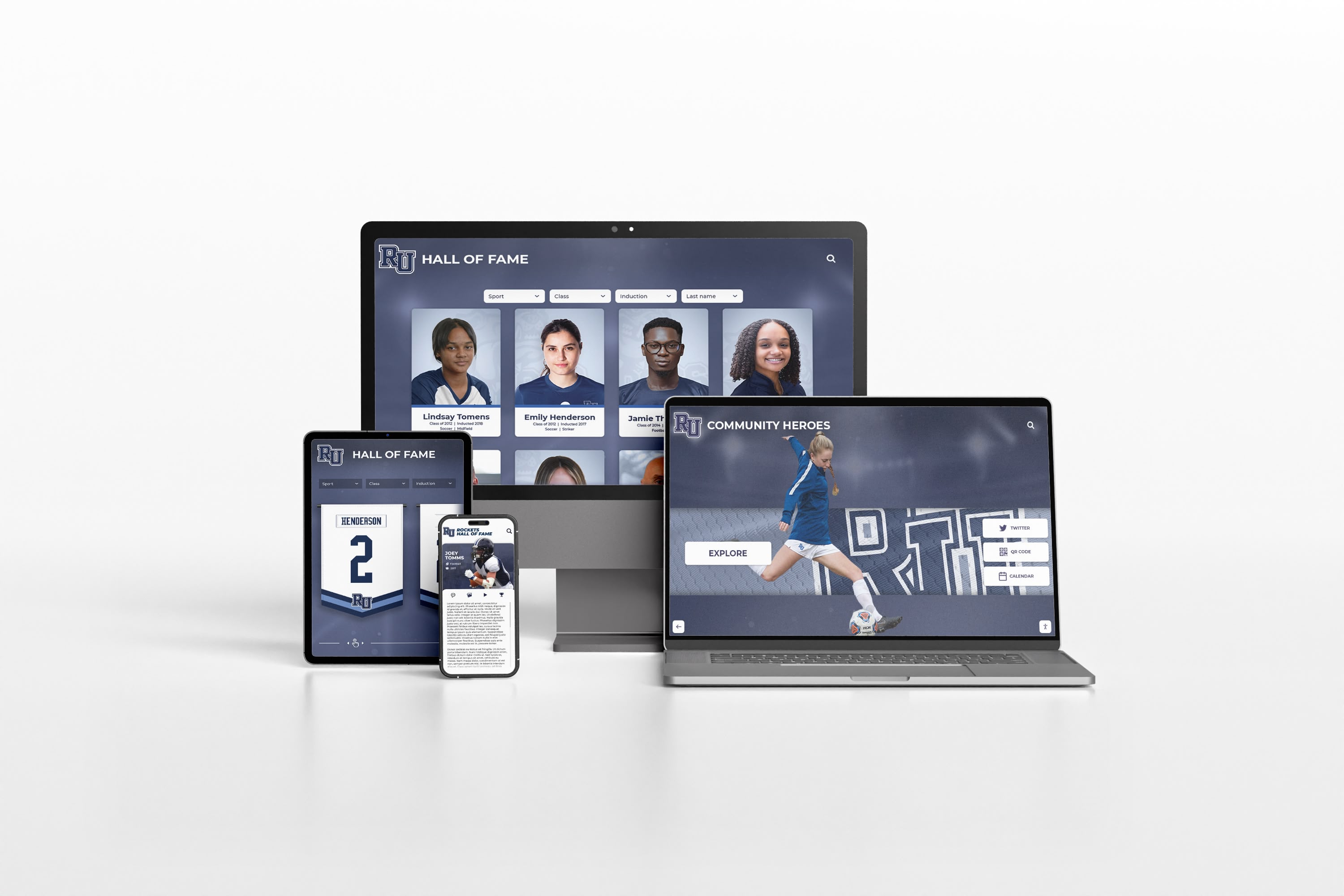
Keep your hall of fame wall current and engaging through regular updates:
- Annual Inductions: Add new honorees according to established schedule
- Content Refreshment: Rotate featured stories, update biographical information, add new multimedia
- Accuracy Corrections: Fix errors or update information as needed
- Technology Updates: Install software patches, security updates, and feature enhancements
- Capacity Planning: Monitor available space and plan expansion before running out of room
For digital installations, establish clear workflows for content development, approval, and publication. Content management systems with role-based access allow multiple staff members to contribute while maintaining quality control through approval processes.
Special Considerations for Different School Types
Elementary and Middle Schools
Recognition programs in younger grades focus on current students and staff:
- Student Achievement Recognition: Academic honors, character awards, service leaders
- Staff Appreciation: Long-serving teachers and administrators
- School History: Founding stories, building evolution, community connections
- Age-Appropriate Content: Design and messaging suitable for younger audiences
- Interactive Elements: Engage students through touchscreens and participatory features
Consider student recognition programs that celebrate ongoing achievements rather than only historical accomplishments.
High Schools
Secondary schools typically implement the most comprehensive hall of fame programs:
- Distinguished Alumni: Graduates who achieved notable success in careers, service, or leadership
- Athletic Championships: Team titles, individual records, coaching legends
- Academic Excellence: Valedictorians, scholars, academic team champions
- Arts Recognition: Performance, visual arts, and creative achievements
- Community Service: Students and alumni making significant service contributions
High schools benefit from interactive touchscreen displays that can accommodate extensive content across multiple recognition categories.
Colleges and Universities
Higher education institutions create the most extensive hall of fame installations:
- Distinguished Alumni Networks: Graduates organized by decade, field, or achievement type
- Faculty Research and Teaching: Professors receiving significant awards or making breakthrough discoveries
- Athletic Programs: Comprehensive sports recognition across all varsity programs
- Institutional Milestones: Buildings, programs, traditions, and evolution
- Donor Recognition: Major benefactors supporting the institution
University-scale projects often involve digital asset management systems to organize extensive photo, video, and document collections.
Private and Religious Schools
Independent schools emphasize institutional values and community:
- Mission Alignment: Recognition criteria reflecting school philosophy and religious values
- Founder and Leadership: Honoring those who established and guided the institution
- Graduate Service: Alumni living institutional values through careers and community involvement
- Benefactor Recognition: Donors enabling school programs and facilities
- Community Impact: School contributions to local and global communities
These institutions often integrate hall of fame recognition with donor recognition displays supporting fundraising objectives.
Budget-Friendly Alternatives and Phased Approaches
Schools with limited budgets can still create meaningful recognition displays:
Low-Cost Traditional Options
Simple approaches delivered with quality materials and good design create impact without large budgets:
- Framed Certificate Walls: Professionally printed certificates in uniform frames arranged in organized grids
- Photo Collage Displays: Large-format prints featuring inductee photos with basic information
- Banner Recognition: Fabric banners featuring honorees hung from ceilings or mounted on walls
- Timeline Murals: Painted or vinyl graphics showing institutional history and key figures
- Simple Plaque Walls: Uniform plaques with essential information in clean, organized arrangements
These approaches typically cost $2,000-$8,000 depending on size and materials—significantly less than comprehensive installations but still delivering meaningful recognition.
Digital Solutions on Modest Budgets
Technology doesn’t have to be expensive to be effective:
- Repurposed Commercial Displays: Consumer-grade large TVs in protective enclosures for simple video playback
- Tablet-Based Kiosks: iPads or Android tablets in secure mounts running simple presentation apps
- Slideshow Displays: Basic digital photo frames cycling through inductee images and information
- Web-Based Recognition: Online hall of fame accessible via QR codes posted at school
- Social Media Integration: Instagram or Facebook showcasing inductees on screens via social feeds
Basic digital displays can be implemented for $1,500-$5,000, though they lack the durability, features, and polish of professional installations.
Phased Implementation Strategies
Consider building your hall of fame wall incrementally:
Phase 1 (Year 1): Basic physical display or simple digital installation Phase 2 (Year 2-3): Expand content, add categories, improve technology Phase 3 (Year 3-5): Upgrade to comprehensive hybrid system with advanced features
Phased approaches distribute costs over multiple budget cycles while allowing schools to refine their vision based on experience with initial implementations.
Measuring Success and Impact
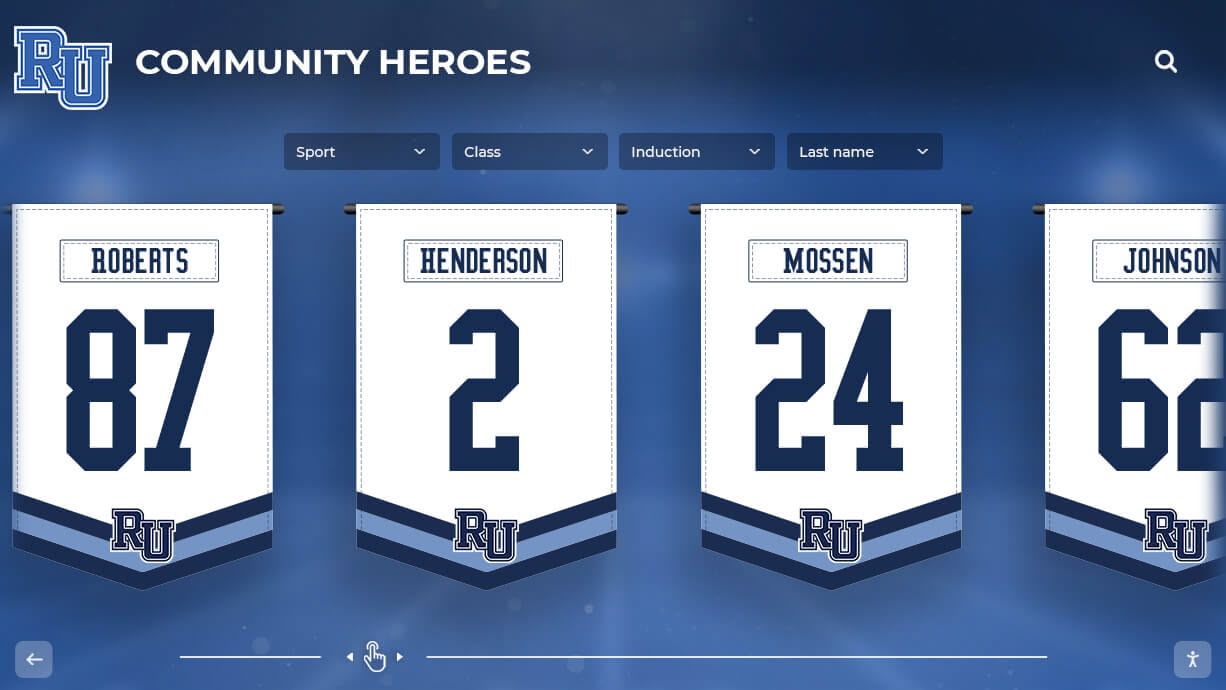
Evaluate whether your hall of fame wall achieves its objectives:
Quantitative Metrics
Track measurable indicators of engagement and impact:
- Visitor Engagement: For digital displays, analytics showing usage frequency, session duration, and features accessed
- Induction Applications: Volume and quality of nomination submissions
- Event Attendance: Participation in induction ceremonies and related events
- Media Coverage: News stories, social media mentions, and external recognition
- Fundraising Impact: Donor participation and contributions connected to recognition programs
Qualitative Assessment
Gather subjective feedback on perception and value:
- User Surveys: Ask students, alumni, and visitors about their experiences with the display
- Testimonial Collection: Document stories about how recognition inspired or connected people
- Committee Feedback: Assess whether the installation meets the needs of those managing the program
- Community Perception: Monitor informal discussions and opinions about the hall of fame
- Alignment with Objectives: Evaluate whether the display accomplishes stated goals
Regular assessment allows continuous improvement and helps justify continued investment in recognition programs.
Common Challenges and Solutions
Limited Physical Space
Many schools struggle with inadequate wall space for traditional displays:
Solutions:
- Choose digital displays with unlimited capacity
- Create online halls of fame accessible via QR codes
- Rotate physical displays showing different inductees periodically
- Use double-sided displays or corner installations maximizing limited space
Budget Constraints
Recognition programs often receive limited funding:
Solutions:
- Implement phased approaches building over multiple years
- Seek alumni donations specifically for hall of fame projects
- Partner with local businesses for sponsorships
- Choose cost-effective materials and technologies appropriate to available budgets
- Focus on content quality rather than expensive finishes
Content Development Capacity
Schools lack staff resources for writing, photography, and multimedia production:
Solutions:
- Engage journalism or media production students in content creation
- Commission professional services for initial development, then maintain in-house
- Use volunteer alumni with relevant professional skills
- Start with basic content and enhance over time as resources allow
- Consider professional support services that include content development assistance
Technology Concerns
Schools worry about maintaining complex digital systems:
Solutions:
- Choose solutions designed for ease of use by non-technical staff
- Select vendors providing comprehensive training and ongoing support
- Ensure IT staff involvement in planning and implementation
- Start with simpler technology and expand as confidence grows
- Consider cloud-based systems with remote management and updates
Criteria and Selection Controversies
Disagreements over who deserves recognition can create problems:
Solutions:
- Establish clear, documented criteria before any selections
- Create diverse selection committees representing multiple constituencies
- Maintain transparency in nomination and selection processes
- Communicate decisions and rationale clearly
- Review and refine criteria periodically based on experience
Future Trends in School Hall of Fame Walls
Recognition technology and practices continue to evolve:
Emerging Technologies
New capabilities are becoming increasingly accessible:
- Augmented Reality: Mobile apps overlaying digital content on physical displays
- Artificial Intelligence: Conversational interfaces allowing natural language queries about inductees
- Holographic Displays: Three-dimensional projections creating immersive experiences
- Virtual Reality: Full immersion in historical moments or achievement environments
- Integration with Smart Buildings: Recognition displays connecting with broader facility technology systems
While cutting-edge technologies generate excitement, focus first on solid execution of fundamental recognition principles. Advanced features add value only when core content and design are excellent.
Evolving Recognition Practices
Schools are reconsidering what and how they recognize:
- Broader Definition of Achievement: Expanding beyond traditional academics and athletics to include service, leadership, arts, and diverse accomplishments
- Recent Graduate Recognition: Honoring young alumni making early-career impact rather than only established figures
- Community Contribution: Recognizing those who strengthened the school community regardless of external achievements
- Staff and Faculty: Expanding recognition beyond students and alumni to honor educators and support staff
- Collective Achievements: Celebrating teams, classes, and groups alongside individual honorees
These evolving practices ensure hall of fame walls remain relevant and inclusive in changing educational environments.
Accessibility and Inclusion Priorities
Modern installations emphasize universal access:
- Physical Accessibility: Mounting heights, clear floor space, and navigation accommodating wheelchairs and mobility devices
- Visual Accommodations: High contrast, large text, and screen reader compatibility
- Cognitive Accessibility: Clear navigation, plain language, and intuitive interfaces
- Multilingual Content: Information in languages reflecting school community demographics
- Diverse Representation: Ensuring recognition reflects full community diversity
Accessibility considerations are becoming central to hall of fame wall design rather than afterthoughts.
Conclusion: Creating Recognition That Inspires
The best school hall of fame walls successfully balance multiple objectives—honoring past achievements while inspiring future excellence, respecting tradition while embracing innovation, and celebrating individuals while strengthening community. Whether you implement a traditional plaque wall, an advanced interactive touchscreen system, or a hybrid approach combining both, success depends on thoughtful planning, quality execution, and ongoing commitment to maintaining an engaging recognition program.
Begin by clearly defining your objectives, establishing transparent selection criteria, and understanding your available resources. Engage stakeholders from across your school community in planning to ensure broad support. Consider both immediate needs and long-term growth when making design and technology decisions.
Remember that the physical installation is only the beginning. The most successful hall of fame walls evolve continuously through regular inductee additions, content updates, and renewed engagement with school communities. Invest not only in initial implementation but also in the ongoing management that keeps recognition programs vibrant and relevant.
Whether your school chooses a modest display or a comprehensive multimedia installation, recognition programs demonstrate that achievements matter, that excellence deserves celebration, and that today’s students can build on the foundations laid by those who came before them. A well-executed hall of fame wall creates connections across generations, inspires current students to strive for greatness, and ensures that exceptional contributions to your school community are never forgotten.
Ready to create a hall of fame wall that honors your school’s legacy while inspiring future achievements? Rocket Alumni Solutions specializes in digital recognition displays designed specifically for educational institutions, offering both technology and expertise to bring your vision to life.



































